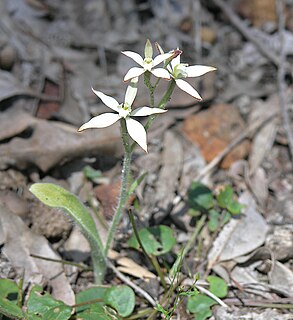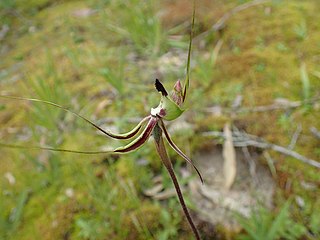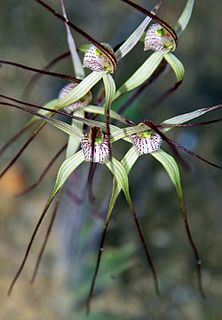
Caladenia marginata, commonly known as the white fairy orchid, is a species of orchid endemic to the south-west of Western Australia. It has a single pale green, hairy leaf and up to four creamy-white flowers and often grows in dense colonies, flowering profusely after summer fires.

Caladenia saccharata, commonly known as sugar orchid, is a species of flowering plant in the orchid family, Orchidaceae and is endemic to the south-west of Western Australia. It has a single leaf and a single flower with three white sepals and two similar petals.
Caladenia abbreviata, commonly known as the coastal spider orchid, is a plant in the orchid family Orchidaceae and is endemic to the south-west of Western Australia. It has a single erect, hairy leaf and up to three pale, creamy-yellow flowers on a flowering stem up to 35 cm (10 in) high. Although the flowers have long, thread-like petals and sepals, they are shorter and darker than those of other spider orchids. It is a rare, relatively recently discovered species although often found near human activities.

Caladenia ambusta, commonly known as the Boranup spider orchid, is a plant in the orchid family Orchidaceae and is endemic to the south-west of Western Australia. It has a single erect, linear leaf and a single creamy-coloured flower on a stem 27–35 cm (11–14 in) high. It is only known from a relatively small area south-west of Margaret River growing in deep sand in shrubland and woodland and only flowering profusely after fire.

Caladenia arrecta, commonly known as the reaching spider orchid, is a plant in the orchid family Orchidaceae and is endemic to the south-west of Western Australia. It has a single erect, hairy leaf and up to three red, yellow and green flowers on a flowering stem up to 35 cm (10 in) high. It is distinguished from the similar C. longiclavata and C. magniclavata by its upswept petals and distinctive calli. Although not common, it is widespread in south-eastern coastal areas.
Caladenia bicalliata subsp. bicalliata, commonly known as the limestone spider orchid or dwarf limestone spider orchid, is a plant in the orchid family Orchidaceae and is native to the south-west of Western Australia and coastal areas of South Australia. It has a single erect, hairy leaf and one or two cream-coloured flowers with reddish-brown tips.
Caladenia bicalliata is a plant in the orchid family Orchidaceae and is native to the south-west of Western Australia and coastal areas of South Australia. It has a single erect, hairy leaf and one or two cream-coloured flowers. There are two subspecies differing in the size and colour of the flowers.

Caladenia christineae, commonly known as Christine's spider orchid, is a plant in the orchid family Orchidaceae and is endemic to the south-west of Western Australia. It has a single erect, hairy leaf and up to four small, white to cream-coloured flowers. It is distinguished from similar spider orchids by its small, odourless flowers with their stiffly held sepals and petals.
Caladenia corynephora, commonly known as the club-lipped spider orchid, is a plant in the orchid family Orchidaceae and is endemic to the south-west of Western Australia. It has a single erect, hairy leaf and one or two greenish-yellow and red flowers which have a labellum with a club-like tip. It is the only Western Australian caladenia with a clubbed labellum.

Caladenia cruscula, commonly known as the reclining spider orchid is a species of orchid endemic to a small area in the south-west of Western Australia. It has a single hairy leaf and a single cream-coloured flower with a long red fringe on the sides of its labellum.

Caladenia exstans, commonly known as the pointing spider orchid, is a species of orchid endemic to a small area in the south-west of Western Australia. It has a single, hairy leaf and one or two green, yellow and red flowers with a labellum which does not curl downwards but "points" forward.
Caladenia graminifolia, commonly known as the grass-leafed spider orchid is a species of orchid endemic to the south-west of Western Australia. It has a single glabrous leaf and one or two short-lived, greenish-yellow and red flowers which have a narrow labellum with long teeth on its sides.

Caladenia hirta subsp. hirta, commonly known as the sugar candy orchid or candy orchid, is a plant in the orchid family Orchidaceae and is endemic to the south-west of Western Australia. It has a single leaf and up to three creamy-white or pink flowers with brownish tips and a brown back.

Caladenia horistes, commonly known as the cream spider orchid is a species of orchid endemic to the south-west of Western Australia. It has a single, hairy leaf and one or two, creamy-yellow flowers which have a red-striped labellum and long, dark, thread-like tips on the sepals and petals.

Caladenia longicauda subsp. rigidula, commonly known as the rigid white spider orchid or island white spider orchid, is a plant in the orchid family Orchidaceae and is endemic to the south-west of Western Australia. It has a single hairy leaf and up to three large, mainly white flowers with relatively short lateral sepals and petals. It is similar to the reclining white spider orchid but that species has smaller, cream-coloured flowers.
Caladenia sigmoidea, commonly known as the sigmoid spider orchid, is a species of orchid endemic to the south-west of Western Australia. It has a single erect, hairy leaf and usually only one red and cream-coloured flowers with an unusual S-shaped labellum.
Caladenia ultima, commonly known as the late spider orchid, is a species of orchid endemic to the south-west of Western Australia. It has a single erect, hairy leaf and up to three creamy-yellow flowers with a red-striped labellum. It is one of the last spiders orchids to flower each year.
Caladenia validinervia, commonly known as the Lake Muir spider orchid, is a species of orchid endemic to the south-west of Western Australia. It has a single erect, hairy leaf and up to three greenish to creamy white flowers with red stripes on the sepals and petals. The flowers have relatively narrow sepals and petals and a relatively small labellum. It is a rare orchid only known from an area between Rocky Gully and Collie.

Caladenia vulgata, commonly known as the common spider orchid, is a species of orchid endemic to the south-west of Western Australia. It is a relatively common and widespread orchid with a single erect, hairy leaf and up to three creamy-white flowers. There is some variation in the species, both in flower colour and growth habit.

Caladenia gemmata, commonly known as the blue china orchid, is a plant in the orchid family Orchidaceae and is endemic to the south-west of Western Australia. It has a small, oval leaf and up to three intense blue to mauve flowers. It is the most common and widespread of the West Australian china orchids, sometimes appearing in large numbers after summer fires.













